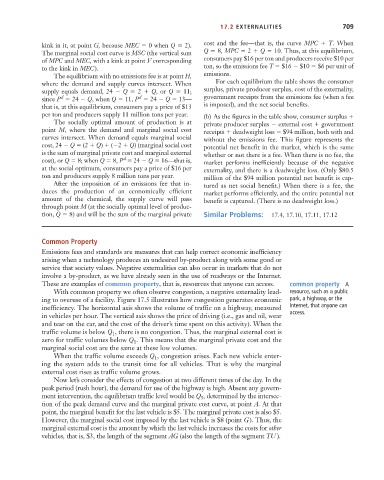Page 735 - Microeconomics, Fourth Edition
P. 735
c17ExternalitiesandPublicGoods.qxd 8/22/10 4:56 AM Page 709
17.2 EXTERNALITIES 709
cost and the fee—that is, the curve MPC T. When
kink in it, at point G, because MEC 0 when Q 2).
The marginal social cost curve is MSC (the vertical sum Q 8, MPC 2 Q 10. Thus, at this equilibrium,
consumers pay $16 per ton and producers receive $10 per
of MPC and MEC, with a kink at point V corresponding
to the kink in MEC). ton, so the emissions fee T $16 $10 $6 per unit of
emissions.
The equilibrium with no emissions fee is at point H,
where the demand and supply curves intersect. When For each equilibrium the table shows the consumer
supply equals demand, 24 Q 2 Q, or Q 11; surplus, private producer surplus, cost of the externality,
d
d
since P 24 Q, when Q 11, P 24 Q 13— government receipts from the emissions fee (when a fee
is imposed), and the net social benefits.
that is, at this equilibrium, consumers pay a price of $13
per ton and producers supply 11 million tons per year. (b) As the figures in the table show, consumer surplus
The socially optimal amount of production is at private producer surplus external cost government
point M, where the demand and marginal social cost receipts deadweight loss $94 million, both with and
curves intersect. When demand equals marginal social without the emissions fee. This figure represents the
cost, 24 Q (2 Q) ( 2 Q) (marginal social cost potential net benefit in the market, which is the same
is the sum of marginal private cost and marginal external whether or not there is a fee. When there is no fee, the
d
cost), or Q 8; when Q 8, P 24 Q 16—that is, market performs inefficiently because of the negative
at the social optimum, consumers pay a price of $16 per externality, and there is a deadweight loss. (Only $80.5
ton and producers supply 8 million tons per year. million of the $94 million potential net benefit is cap-
After the imposition of an emissions fee that in- tured as net social benefit.) When there is a fee, the
duces the production of an economically efficient market performs efficiently, and the entire potential net
amount of the chemical, the supply curve will pass benefit is captured. (There is no deadweight loss.)
through point M (at the socially optimal level of produc-
tion, Q 8) and will be the sum of the marginal private Similar Problems: 17.4, 17.10, 17.11, 17.12
Common Property
Emissions fees and standards are measures that can help correct economic inefficiency
arising when a technology produces an undesired by-product along with some good or
service that society values. Negative externalities can also occur in markets that do not
involve a by-product, as we have already seen in the use of roadways or the Internet.
These are examples of common property, that is, resources that anyone can access. common property A
With common property we often observe congestion, a negative externality lead- resource, such as a public
ing to overuse of a facility. Figure 17.5 illustrates how congestion generates economic park, a highway, or the
inefficiency. The horizontal axis shows the volume of traffic on a highway, measured Internet, that anyone can
in vehicles per hour. The vertical axis shows the price of driving (i.e., gas and oil, wear access.
and tear on the car, and the cost of the driver’s time spent on this activity). When the
traffic volume is below Q , there is no congestion. Thus, the marginal external cost is
1
zero for traffic volumes below Q . This means that the marginal private cost and the
1
marginal social cost are the same at these low volumes.
When the traffic volume exceeds Q , congestion arises. Each new vehicle enter-
1
ing the system adds to the transit time for all vehicles. That is why the marginal
external cost rises as traffic volume grows.
Now let’s consider the effects of congestion at two different times of the day. In the
peak period (rush hour), the demand for use of the highway is high. Absent any govern-
ment intervention, the equilibrium traffic level would be Q , determined by the intersec-
5
tion of the peak demand curve and the marginal private cost curve, at point A. At that
point, the marginal benefit for the last vehicle is $5. The marginal private cost is also $5.
However, the marginal social cost imposed by the last vehicle is $8 (point G). Thus, the
marginal external cost is the amount by which the last vehicle increases the costs for other
vehicles, that is, $3, the length of the segment AG (also the length of the segment TU ).

